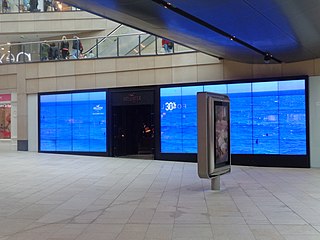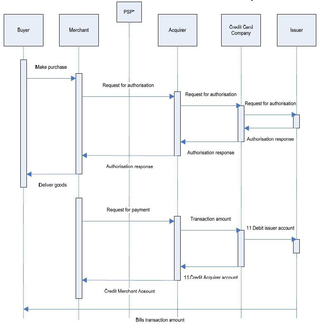Related Research Articles
E-commerce is the activity of electronically buying or selling products on online services or over the Internet. E-commerce draws on technologies such as mobile commerce, electronic funds transfer, supply chain management, Internet marketing, online transaction processing, electronic data interchange (EDI), inventory management systems, and automated data collection systems. E-commerce is the largest sector of the electronics industry and is in turn driven by the technological advances of the semiconductor industry.

Marketing is the act of satisfying and retaining customers. It is one of the primary components of business management and commerce.

Sales are activities related to selling or the number of goods sold in a given targeted time period. The delivery of a service for a cost is also considered a sale. A period during which goods are sold for a reduced price may also be referred to as a "sale".
Marketing research is the systematic gathering, recording, and analysis of qualitative and quantitative data about issues relating to marketing products and services. The goal is to identify and assess how changing elements of the marketing mix impacts customer behavior.

Distribution is the process of making a product or service available for the consumer or business user who needs it, and a distributor is a business involved in the distribution stage of the value chain. Distribution can be done directly by the producer or service provider or by using indirect channels with distributors or intermediaries. Distribution is one of the four elements of the marketing mix: the other three elements being product, pricing, and promotion.
Electronic business is any kind of business or commercial transaction that includes sharing information across the internet. Commerce constitutes the exchange of products and services between businesses, groups, and individuals and can be seen as one of the essential activities of any business.
Business-to-government (B2G), also known as business-to-public-administration (B2PA) or business-to-public-sector (B2PS) refers to trade between the business sector as a supplier and a government body as a customer playing a major impact in public procurement. Business-to-government also includes the segment of business-to-business (B2B) marketing known as public sector marketing — a form of business-to-business-to-government (B2B2G) phenomenon, which encompasses marketing products and services to various government levels—local, state/provincial, and national—through integrated marketing communications techniques such as strategic public relations, branding, marketing communications, advertising, and web-based communications.
Database marketing is a form of direct marketing that uses databases of customers or potential customers to generate personalized communications in order to promote a product or service for marketing purposes. The method of communication can be any addressable medium, as in direct marketing.

Business-to-business is a situation where one business makes a commercial transaction with another. This typically occurs when:
The eCRM or electronic customer relationship management coined by Oscar Gomes encompasses all standard CRM functions with the use of the net environment i.e., intranet, extranet and internet. Electronic CRM concerns all forms of managing relationships with customers through the use of information technology (IT).
B2B e-commerce, short for business-to-business electronic commerce, is the sale of goods or services between businesses via an online sales portal. In general, it is used to improve the efficiency and effectiveness of a company's sales efforts. Instead of receiving orders using human assets manually – by telephone or e-mail – orders are received digitally, reducing overhead costs.
Business marketing is a marketing practice of individuals or organizations. It allows them to sell products or services to other companies or organizations that resell them, use them in their products or services, or use them to support their works. It is a way to promote business and improve profit too.
An online marketplace is a type of e-commerce website where product or service information is provided by multiple third parties. Online marketplaces are the primary type of multichannel ecommerce and can be a way to streamline the production process.
The following outline is provided as an overview of and topical guide to marketing:
Business-to-employee (B2E) electronic commerce uses an intrabusiness network which allows companies to provide products and/or services to their employees. Typically, companies use B2E networks to automate employee-related corporate processes. B2E portals have to be compelling to the people who use them. Companies are competing for eyeballs of their employees with eBay, yahoo and thousands of other web sites. There is a huge percentage of traffic to consumer web sites comes from people who are connecting to the net at the office.
Customer to customer markets provide a way to allow customers to interact with each other. Traditional markets require business to customer relationships, in which a customer goes to the business in order to purchase a product or service. In customer to customer markets, the business facilitates an environment where customers can sell goods or services to each other. Other types of markets include business to business (B2B) and business to customer (B2C).

Electronic commerce, commonly known as e-commerce or eCommerce, or e-business consists of the buying and selling of products or services over electronic systems such as the Internet and other computer networks. The amount of trade conducted electronically has grown extraordinarily with widespread Internet usage. The use of commerce is conducted in this way, spurring and drawing on innovations in electronic funds transfer, supply chain management, Internet marketing, online transaction processing, electronic data interchange (EDI), inventory management systems, and automated data collection systems. Modern electronic commerce typically uses the World Wide Web at least at some point in the transaction's lifecycle, although it can encompass a wider range of technologies such as e-mail as well.
Business-to-many or B2M is a marketing term for a business that sells their goods or services to other businesses as well as to consumers. Unlike B2B firms that only engage themselves with other businesses or retail firms (B2C) that only contact consumers or the end users of the product, B2M firms do both. It is important to understand that just because an organization does B2M marketing, this does not mean that they target their products and services to everyone. B2M companies, like any other type of company, have a more specific target audience.
Marketing automation refers to software platforms and technologies designed for marketing departments and organizations automate repetitive tasks and consolidate multi-channel interactions, tracking and web analytics, lead scoring, campaign management and reporting into one system. It often integrates with customer relationship management (CRM) and customer data platform (CDP) software.
There are many types of e-commerce models, based on market segmentation, that can be used to conducted business online. The 6 types of business models that can be used in e-commerce include: Business-to-Consumer (B2C), Consumer-to-Business (C2B), Business-to-Business (B2B), Consumer-to-Consumer (C2C), Business-to-Administration (B2A), and Consumer-to-Administration
References
- ↑ "How Big Data Analytics Drive Consumer-to-Business Marketing". January 26, 2016. Archived from the original on January 27, 2021. Retrieved July 24, 2020.
- 1 2 3 4 5 "What is C2B?". Business News Daily. Retrieved October 22, 2018.
- ↑ Chen, Deng-Neng (October 11, 2006). "An agent-based model for consumer-to-business electronic commerce". Expert Systems with Applications.
- ↑ Doyle, Charles (2016). Oxford Dictionary of Marketing. Online: Oxford University Press. ISBN 9780198736424.
- ↑ Raciti, Maria M.; Ward, Tony; Dagger, Tracey S. (March 29, 2013). "The effect of relationship desire on consumer‐to‐business relationships". European Journal of Marketing. 47 (3/4): 615–634. doi:10.1108/03090561311297490. ISSN 0309-0566.[ permanent dead link ]
- ↑ "Forget B2B or B2C—It's About C2B". DMNews.com. Retrieved October 22, 2018.
- ↑ Leo, Malcolm De (October 28, 2011). "C2B: How Social Media Is Flipping Who Has Control". GreenBook. Retrieved June 22, 2020.
- ↑ "Yelp Privacy Policy". terms.yelp.com. Retrieved June 22, 2020.